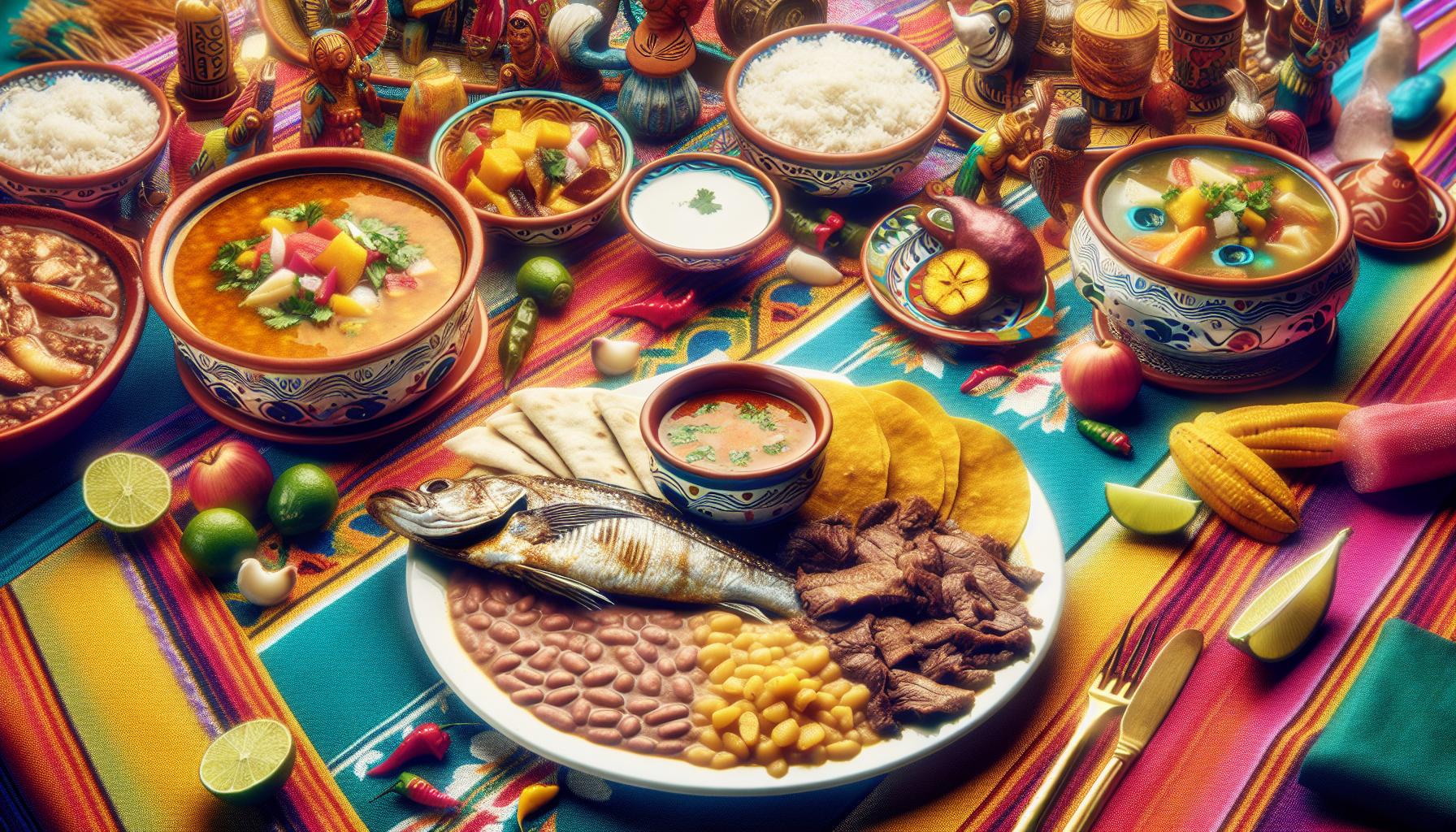Honduras Culture Food is a vibrant tapestry of flavors that tells the story of a nation’s rich cultural heritage. From the sizzling street food markets of Tegucigalpa to the coastal kitchens of La Ceiba, every bite offers a taste of centuries-old traditions blended with indigenous, Spanish, and Caribbean influences.
At the heart of Honduran food culture lies the beloved baleada – a thick flour tortilla stuffed with refried beans, cream, and cheese. But that’s just the beginning of the country’s culinary adventure. The diverse landscape of Honduras, from its pristine beaches to lush mountains, has shaped a cuisine that’s as varied as its terrain. Whether it’s the coconut-infused seafood dishes of the Caribbean coast or the hearty mountain fare of the interior, Honduras’s food scene is an undiscovered treasure waiting to be savored.
Honduras Culture Food
Honduras Culture Food embodies centuries of cultural fusion with diverse ingredients reflecting its complex history. The culinary landscape combines indigenous staples with Spanish colonial influences creating distinctive flavor profiles.
Historical Influences on Honduran Food
Indigenous Mesoamerican cooking techniques form the foundation of Honduran cuisine through corn-based dishes like tamales tortillas. Spanish colonizers introduced cattle farming which brought beef pork dairy products into traditional recipes. African Caribbean influences added coconut-based preparations plantains tropical fruits to coastal dishes. The Garifuna people contributed unique cooking methods focusing on seafood coconut milk yuca root. The Maya civilization’s agricultural practices established the cultivation of beans squash cacao which remain essential ingredients in modern Honduran dishes.
- Cortés: Industrial food production modern fusion cuisine
- Atlántida: Caribbean-style seafood coconut-based dishes
- Olancho: Cattle ranching influences meat-focused meals
- Comayagua: Colonial-era recipes preserved cooking methods
- Gracias: Indigenous cooking techniques mountain ingredients
Traditional Honduran Staple Foods

Honduras Culture Food centers on simple yet flavorful staple ingredients that form the foundation of daily meals. These fundamental elements combine traditional cooking methods with locally sourced ingredients to create distinctive dishes that sustain communities across the country.
Baleadas and Street Food Favorites
Baleadas reign as Honduras’s most iconic street food, featuring thick flour tortillas folded over refried beans, crema, queso fresco. Street vendors enrich these handheld meals with additional toppings like scrambled eggs, avocado or chorizo. Popular street snacks include pastelitos (fried corn pastries filled with meat or potatoes), enchiladas hondureñas (crispy corn tortillas topped with ground beef, shredded cabbage, tomato sauce) and tacos fritos (rolled corn tortillas filled with chicken or beef). Elotes (grilled corn on the cob slathered in mayo, cheese, chili) appear at street corners throughout Honduras while catrachas (open-faced tortillas topped with refried beans, cheese, ground beef) satisfy hungry crowds at local markets.
Rice, Beans and Tortillas
Rice and beans form the cornerstone of Honduran meals, with red beans simmered until creamy then served alongside white rice. Fresh corn tortillas accompany every meal, handmade daily on traditional comals (flat griddles). Casamiento combines rice and beans into a single dish, often seasoned with onions, peppers, garlic. Hondurans prepare tortillas using both corn masa and wheat flour, though corn remains the traditional choice. Local variations include machuca (mashed green plantains with coconut milk) in coastal regions, while mountain communities favor thick corn tortillas called pupusas. These staples provide essential nutrition through proteins, carbohydrates, fiber.
Popular Main Dishes and Meats

Honduras Culture Food showcase hearty combinations of meats, beans, plantains, rice, and traditional seasonings. The country’s diverse culinary traditions reflect regional specialties from mountain valleys to coastal areas.
Plato Típico
The Plato Típico represents Honduras’s national dish, combining grilled beef, white rice, refried beans, plantains, sour cream, chimol salsa, avocado, and fresh corn tortillas. Local variations add charred pork chops or grilled chicken to this traditional plate. Restaurants serve this filling meal throughout the day, with many establishments offering their signature preparations. Special touches include marinated meat strips, crispy plantain chips, and homemade corn tortillas patted by hand. The dish incorporates fresh herbs like cilantro, oregano, cumin for authentic Honduran flavors.
Seafood Specialties
Coastal regions of Honduras offer distinctive seafood preparations influenced by Caribbean cooking methods. Fresh red snapper, grouper, shrimp, lobster take center stage in traditional dishes like sopa marinera, a rich seafood soup loaded with shellfish, coconut milk, plantains, yuca. Pescado frito serves whole fried fish with tajadas, coconut rice, fresh lime. The Garifuna communities prepare machuca, mashing plantains with coconut broth, serving it alongside fresh-caught fish soup. Popular coastal preparations include conch ceviche, grilled octopus, pan-seared corvina with garlic butter sauce.
Honduran Drinks and Beverages

Honduras Culture Food beverages reflect the country’s tropical climate and agricultural heritage through a diverse selection of fresh fruit drinks and traditional hot preparations. These drinks incorporate local ingredients like coffee beans from mountain regions and tropical fruits from coastal areas.
Traditional Hot and Cold Beverages
Honduras Culture Food produces distinct beverages ranging from fresh fruit-based refrescos to aromatic coffee preparations. Popular cold drinks include horchata, a rice-based drink flavored with cinnamon and vanilla, and pinol, made from toasted corn and cocoa. Licuados blend fresh tropical fruits like papaya, mango and pineapple with milk or water. Traditional hot beverages feature locally grown coffee served black or with milk as café con leche. Atol de elote combines fresh corn, milk and cinnamon into a warm, creamy drink. Aguardiente, a sugarcane-based spirit, represents the traditional alcoholic beverage category. Coconut water straight from young green coconuts offers refreshment along coastal areas.
| Beverage Type | Key Ingredients | Serving Style |
|---|---|---|
| Horchata | Rice, cinnamon, vanilla | Cold |
| Pinol | Toasted corn, cocoa | Cold |
| Atol de elote | Fresh corn, milk, cinnamon | Hot |
| Licuados | Tropical fruits, milk/water | Cold |
| Café con leche | Coffee, milk | Hot |
Festivals and Food Celebrations
Honduran festivals feature distinctive culinary traditions that unite communities through shared meals. Traditional celebrations combine religious observances with local food customs that reflect the country’s cultural heritage.
Holiday Food Traditions
Semana Santa (Holy Week) celebrations feature special dishes like pescado seco (dried fish) served with rice, plantains, and spices. Christmas Eve dinner centers around nacatamales, large corn-based tamales filled with pork, rice, potatoes, and olives wrapped in banana leaves. Independence Day celebrations on September 15th showcase Honduras’s national dishes, including plato típico, baleadas, and traditional desserts like tres leches cake. During Day of the Dead (November 2), families prepare rosquillas, traditional corn-based donuts, and torrejas (Honduran french toast) to honor deceased loved ones. The Feria Juniana in San Pedro Sula features street food festivals with regional specialties like yuca con chicharrón and coconut-based treats.
Modern Honduran Food Culture
Honduras Culture Food embraces both traditional recipes and contemporary influences, creating a dynamic culinary landscape that reflects changing lifestyles. Urban areas showcase evolving food preferences while maintaining deep connections to cultural heritage.
Contemporary Dining Customs
Modern Honduran families typically share three main meals daily, with lunch remaining the largest family gathering. Urban professionals often grab quick baleadas or pupusas from street vendors during lunch breaks. Coffee shops dot city centers, offering traditional café con leche alongside international espresso drinks. Restaurant culture thrives in major cities like Tegucigalpa San Pedro Sula where fusion cuisines blend local ingredients with global cooking techniques.
Popular dining trends include:
- Food courts in shopping centers serving traditional dishes in modern settings
- Family-style restaurants offering updated versions of classic recipes
- Food delivery apps connecting customers to local eateries
- International restaurant chains adapting menus to include Honduran flavors
| Meal | Typical Time | Common Foods |
|---|---|---|
| Breakfast | 6-8 AM | Eggs, beans, plantains, tortillas |
| Lunch | 12-2 PM | Plato típico, soups, grilled meats |
| Dinner | 6-8 PM | Lighter versions of lunch dishes |
Honduran cuisine stands as a vibrant testament to the country’s cultural diversity and rich history. From the iconic baleada to traditional festival foods the culinary landscape offers a fascinating blend of indigenous Mesoamerican African Caribbean and Spanish influences.
The combination of regional specialties traditional cooking methods and modern adaptations has created a unique food culture that continues to evolve while honoring its roots. Whether enjoying street food in urban centers or traditional dishes during festivals Honduras’s culinary heritage remains an essential part of its national identity.
Every bite of Honduran food tells a story of tradition innovation and community making it a truly remarkable cuisine worth exploring and celebrating.



